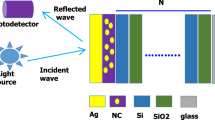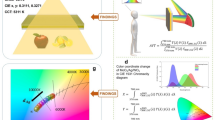Abstract
A transparent-conductive film (TCF) is widely used in various electro-optical devices. The dielectric/metal/dielectric (D/M/D) as one type of TCF has been highly considered due to more advantages, such as the possibility of selecting different materials and engineering other properties. For pre-fabrication design, it is often modeled with a 1D photonic crystal. This model needs to be improved due to the low thickness of the metal layer since a very thin metallic layer leads to a nanostructure instead of a uniform layer. In this study, after proper nanostructure modeling, the 3D-FDTD method was used to simulate different optical properties of the structure. The first aspect of the importance of the nanostructured model is to address the serious plasmonic losses. They are associated with the complicated metallic form in D/M/D that is not considered in conventional modeling. The simulation results showed that for Ag, plasmonic loss peaks demonstrate a wide distribution over the visible spectrum. These peaks show a more significant distribution near the UV–visible border for Al nanostructure. In both, the behavior of optical plasmonic loss tends to redshift compared to their bulk plasmonic peaks. Concerning optical transmission, Al does not offer a notable advantage over Ag. Due to the intense excitation of plasmonic modes when the metal layer has pores, a layer of entirely connected nanoparticles with the least possible thickness can have the desired optical properties. The increased rough surface of the dielectric layer due to the nanostructured metallic layer was also modeled.









Similar content being viewed by others
Data Availability
Due to the increased size of the file after each simulation (usually around 50 GB or more), their storage is faced with hardware limitations.
Code Availability
The Lumerical simulator is used for FDTD simulation.
References
Ginley DS, Hosono H, Paine DC (2010) Handbook of transparent conductors. Springer, US
Levy D, Castellón E (2019) Transparent Conductive Materials: Materials, Synthesis, Characterization, Applications. Wiley
Jakšić Z (2014) Micro and nanophotonics for semiconductor infrared detectors: towards an ultimate uncooled device. Springer International Publishing
Zhao W (2011) Flexible transparent electrically conductive polymer films for future electronics. University of Akron
Marus M et al (2015) Optoelectronic performance optimization for transparent conductive layers based on randomly arranged silver nanorods. Opt Express 23(5):6209–6214
Rodrigo SG et al (2009) Extraordinary optical transmission through hole arrays in optically thin metal films. Opt Lett 34(1):4–6
Chen Z et al (2013) Fabrication of Highly Transparent and conductive indium–tin oxide thin films with a high figure of merit via solution processing. Langmuir 29(45):13836–13842
Walker A et al (2016) Unconventional thin film photovoltaics: RSC energy and environment series. R Soc Chem
Cattin L, Bernède JC, Morsli M (2013) Toward indium‐free optoelectronic devices: dielectric/metal/dielectric alternative transparent conductive electrode in organic photovoltaic cells. physica status solidi (a). 210(6):1047-61
Akdemir O et al (2020) MoOx/Ag/MoOx multilayers as hole transport transparent conductive electrodes for n-type crystalline silicon solar cells. Int J Energy Res 44(4):3098–3109
Barquinha P, Martins R, Pereira L, Fortunato E (2012) Transparent Oxide Electronics: From Materials to Devices. Wiley
Gould RD, Kasap S, Ray AK (2017) Thin films. In: Kasap S, Capper P (eds) springer handbook of electronic and photonic materials. Springer International Publishing, Cham, pp 1–1
Katsidis CC, Siapkas DI (2002) General transfer-matrix method for optical multilayer systems with coherent, partially coherent, and incoherent interference
Yang J et al (2020) Numerical and experimental investigation of highly flexible, transparent, and conductive WO3/Ag/PEI/CuSCN multilayered electrodes. Optical Materials Express 10(12):3257–3267
Cattin L et al (2020) On the contribution of fullerene to the current of planar heterojunction organic solar cells. J Phys D Appl Phys 31;53(22):225501
Kim S, Lee JL (2012) Design of dielectric/metal/dielectric transparent electrodes for flexible electronics. J Photon Energy 2(1):021215
Ohring M (2002) Materials Science of Thin Films. Elsevier Science
Baburin AS et al (2019) Silver-based plasmonics: golden material platform and application challenges [Invited]. Opt Mater Express 9(2):611–642
Musa SM (2017) Computational nanotechnology using finite difference time domain. CRC Press
Nguyen DT et al (2012) Effect of the thickness of the MoO3 layers on optical properties of MoO3/Ag/MoO3 multilayer structures. Int J Appl Phys 112(6):063505
Lim S-H, Kim H-K (2020) Deposition Rate effect on optical and electrical properties of thermally evaporated WO3−x/Ag/WO3−x multilayer electrode for transparent and flexible thin film heaters. Sci Rep 10(1):8357
Malik O (2017) Sputtered indium tin oxide films for optoelectronic applications. IntechOpen
Venkatachalam S (2011) Optoelectronic properties of ZnSe, ITO, TiO2 and ZnO thin films. IntechOpen
Rockett A (2007) Thin film growth processes, in The Materials Science of Semiconductors. Springer, US
Martin J, Plain J (2014) Fabrication of aluminium nanostructures for plasmonics. J Phys D Appl Phys 48(18):184002
Ji C et al (2020) Ultrathin-metal-film-based transparent electrodes with relative transmittance surpassing 100%. Nat Commun 11(1):3367
Babeva T (2021) Optical thin films and structures: design and advanced applications. MDPI AG
Hergert W, Wriedt T (2012) The Mie theory: basics and applications. Springer, Berlin Heidelberg
Martín-Moreno L et al (2001) Theory of extraordinary optical transmission through subwavelength hole arrays. Phys Rev Lett 86(6):1114–1117
Shi W-B et al (2018) Strong localization of surface plasmon polaritons with engineered disorder. Nano Lett 18(3):1896–1902
Zhu Y et al (2020) Realizing Anderson localization of surface plasmon polaritons and enhancing their interactions with excitons in 2D disordered nanostructures. Appl Phys Lett 116(20):201106
Huang Q et al (2019) Graphene–gold–Au@Ag NPs-PDMS films coated fiber optic for refractive index and temperature sensing. IEEE Photonics Technol Lett 31(15):1205–1208
Ye Y et al (2019) Plasmonics of diffused silver nanoparticles in silver/nitride optical thin films. Sci Rep 9(1):20227
Acknowledgements
Thanks to Shahrekord University’s rapid computing center for providing the simulations.
Author information
Authors and Affiliations
Corresponding author
Ethics declarations
Conflict of Interest/Competing Interests
The author declares no competing interests.
Additional information
Publisher's Note
Springer Nature remains neutral with regard to jurisdictional claims in published maps and institutional affiliations.
Rights and permissions
About this article
Cite this article
Haidari, G. Nano-viewpoint in Modeling and Investigation of the D/M/D Transparent-Conductive Layer. Plasmonics 17, 249–255 (2022). https://doi.org/10.1007/s11468-021-01523-5
Received:
Accepted:
Published:
Issue Date:
DOI: https://doi.org/10.1007/s11468-021-01523-5




